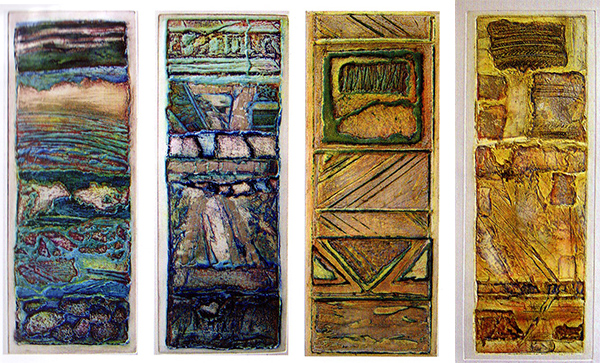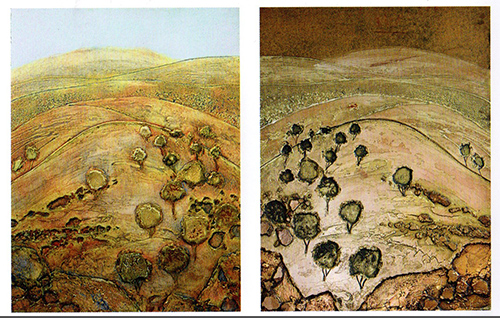 A couple of weeks ago in anticipation of starting the collagraph section of my course I opened the recommended textbook (for this section) for the first time. I haven’t put it down since. I was immediately struck by the organic nature of the prints by Brenda Hartill, the colour choices and blending, the movement, light and depth in each piece and the techniques she employs.
A couple of weeks ago in anticipation of starting the collagraph section of my course I opened the recommended textbook (for this section) for the first time. I haven’t put it down since. I was immediately struck by the organic nature of the prints by Brenda Hartill, the colour choices and blending, the movement, light and depth in each piece and the techniques she employs.
I immediately went to her website and wrote asking if I could use some of her pictures (from the book) in my on-line learning log. Not 24 hours later and I had a very gracious reply assuring me it would be fine as long as I credited her.
Brenda has been experimenting and printing for over 25 years and she has built up vast personal knowledge. One of her main interests is texture in printmaking, from both the effects of ink coverage using collage and also embossing by manipulating paper sculpturally. I’m fascinated by her blind embossing techniques whereby she creates an image using no ink. How is this possible? Essentially paper is printed in some areas without ink but the collagraph plate textures emboss into the paper surface as it goes through the press bringing dimension, shadows and stark white feature areas.
 Even though I enjoy the blind embossing idea I am even more taken with the prints above, part of the Variations VII series. Now this is where I would like to go. Fabulous, fabulous prints. I can just see the texture jumping out of the paper. Colour choices, the use of dominant and quite sharply defined areas sitting forward from softer blended backgrounds and the clear transfer of the collaged materials really reaches out to me. I like this print style a lot. These have been produced from collage plates using broken and carved chipboard, filler, glue and in some places silver leaf. Ink has been applied using rubs rather than a roller.
Even though I enjoy the blind embossing idea I am even more taken with the prints above, part of the Variations VII series. Now this is where I would like to go. Fabulous, fabulous prints. I can just see the texture jumping out of the paper. Colour choices, the use of dominant and quite sharply defined areas sitting forward from softer blended backgrounds and the clear transfer of the collaged materials really reaches out to me. I like this print style a lot. These have been produced from collage plates using broken and carved chipboard, filler, glue and in some places silver leaf. Ink has been applied using rubs rather than a roller.
 Here I’m showing something less abstract but equally as appealing. The print is on the left, entitled Hillock with olive trees. The plate is pictured to the right and the level of work involved in creating it was very complex and long-winded with many steps including drying time in between techniques, cutting, banging, gouging, carving, layering materials and so on. You really need to buy the book to learn these methods, it’s not for me to go into great detail.
Here I’m showing something less abstract but equally as appealing. The print is on the left, entitled Hillock with olive trees. The plate is pictured to the right and the level of work involved in creating it was very complex and long-winded with many steps including drying time in between techniques, cutting, banging, gouging, carving, layering materials and so on. You really need to buy the book to learn these methods, it’s not for me to go into great detail.
It’s a print with a certain amount of detail but still with a loose and free feel to it. Brenda has explained in good detail how she has achieved some of her pieces and that everyone should take her methods and adapt them to their own way of working and see what results.
With that in mind, I have commenced constructing my first ‘Brenda Hartill inspired’ collagraph plate having adapted her material ideas to my own choice of items.
Resources:
Brenda Hartill & Richard Clarke, Collagraphs and Mixed-Media Printmaking. Published by Bloomsbury, London, 2005 – reprinted 2007, 2012. ISBN 978-0-7136-6396-9. Various pages.
http://www.atticgallery.co.uk/scripts/prodlist.asp?idcategory=232
http://www.youtube.com/results?search_query=brenda+hartill
http://www.brendahartill.com
Permission to use images kindly given by the artist.
